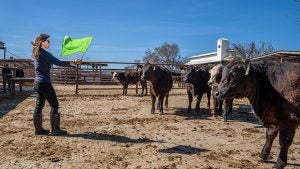What is “animal personality”?
Personality is the trend in behavior over the lifetime of an animal. For example, Animal “A” is more aggressive than Animal “B” during feeding, territory defense, and mating, while Animal “C” is more fearful than both Animal “A” and “B”. An animal’s personality may impact their immunity strength (Bolhuis et al., 2003; Capitanio et al., 1999), their ability to cope with physiological stress (Carere et al., 2010), and the likelihood of performing abnormal or stereotypic behaviors (Ijichi et al., 2013; Cussen and Mench, 2015).

How do you “measure” an animal’s personality?
Given that personality is most clearly expressed in novel and unpredictable situations, behavioral tests are constructed to elicit high-arousal responses. These tests include: restraint, isolation in open field, exposure to novel object, competition for feed, exposure to unfamiliar animal, and reaction to a human approach.
Behavioral Experiments |
Description |
Behaviors recorded |
| Restraint Test | Limit the movement of an animal for a brief period of time, for example by tethering, or by close confinement in a weighing crate. | Vocalization, freezing, and escape attempts. |
| Open Field Test | Separate animal from its pen or herd mates and place it in a novel arena for brief time. | Vocalization, exploration, freezing, and activity. |
| Novel Object Test | Animal is presented a species-relevant object in home pen/pasture or experimental arena. | Latency to approach, duration of contact, and average distance from object. |
| Feeding Competition | Measure aggression and social rank by placing a single highly-valued food source in a pen/pasture with a certain number of animals. | Aggression, duration/rate of food access, latency to approach food resource, and displacement at food resource. |
| Resident-Intruder Test | Single animal is confronted with unknown conspecific in their home pen/pasture. | Aggression, tactile contact, and inter-animal distance. |
| Human Approach Test | Animal is placed in solitary arena with an unfamiliar human. The location of experiment can be familiar (home pen) or unfamiliar (open field test). | Latency to approach a human (Voluntary Approach), or the response to an approach by a human (Forced Approach), and frequency/duration of tactile contact. |
References
Boissy, A. (1995). Fear and fearfulness in animals. Quarterly Review of Biology, 70, 165-191.
Bolhuis, J. E., Parmentier, H. K., Schouten, W. G., Schrama, J. W., & Wiegant, V. M. (2003). Effects of housing and individual coping characteristics on immune responses of pigs. Physiology & Behavior, 79, 289-296.
Capitanio, J. P., Mendoza, S. P., & Baroncelli, S. (1999). The relationship of personality dimensions in adult male rhesus macaques to progression of simian immunodeficiency virus disease. Brain, Behavior, and Immunity, 13, 138-154.
Carere, C., Caramaschi, D., & Fawcett, T. (2010). Covariation between personalities and individual differences in coping with stress: converging evidence and hypotheses. Current Zoology, 56, 728-740.
Cussen, V., & Mench, J. (2015). The relationship between personality dimensions and resiliency to environmental stress in orange-winged amazon parrots, as indicated by the development of abnormal behaviors. PloS one, 10, e0126170.
Ijichi, C., Collins, L., & Elwood, R. (2013). Evidence for the role of personality in stereotypy predisposition. Animal Behavior, 85, 1145–1151.
Ijichi, C., Collins, L., & Elwood, R. (2014). Pain expression is linked to personality in horses. Applied Animal Behavior Science, 152, 38–43.
Korte, S. (2001). Corticosteroids in relation to fear, anxiety and psychopathology. Neuroscience & Biobehavioral Reviews. 25, 117–142.
Massen, J., & Koski, S. (2014). Chimps of a feather sit together: chimpanzee friendships are based on homophily in personality. Evolution and Human Behavior. 35, 1–8.
Stamps, J., & Groothuis, T. (2010). The development of animal personality: relevance, concepts and perspectives. Biological Review. 85, 301–325.